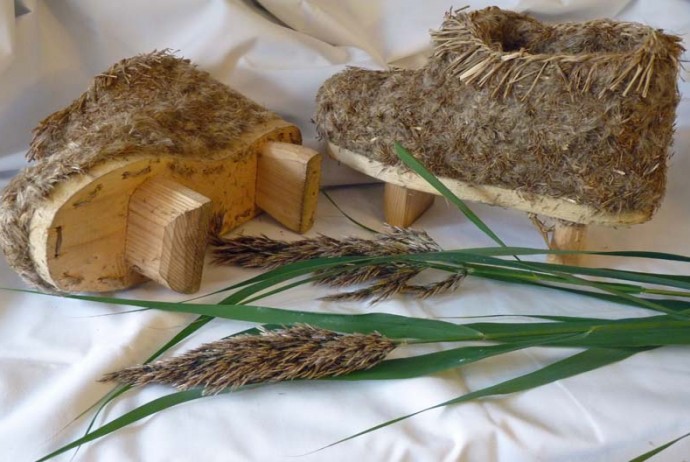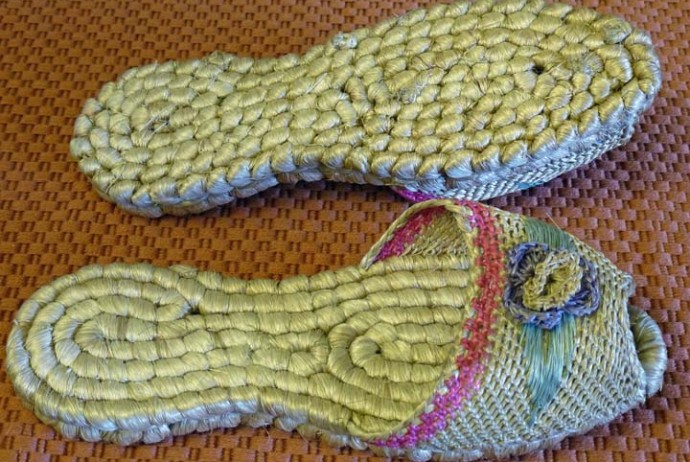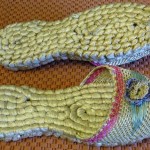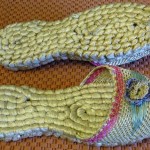My friend Donna Crispin, a fiber artist from Eugene Oregon, took these photos during a recent family trip to Nepal. Bhaktapur is near the capitol and is a popular city among tourists. It was great to see these straw sandals among the ‘products’ for sale in the shop. They are a simpler version of item #NP1 in The Collection, made with essentially the same construction techniques, but no decoration. NP1 has an interesting history. It was purchased at a market in New York City and the buyer thought it was from Nepal. This pretty much confirms it!
Author Archives: Joan
Migrating woven shoes from Eastern Europe?
This is the story of two almost identical pairs of woven shoes. The first pair was purchased on Ebay in December of 2012. The owner of Prioritybargains told me that they were found in a flea market in Northwest Oklahoma. He said that there were no marks on the shoes and so he assumed they may have been produced locally, perhaps by a Native American weaver. I decided to add them to the Americas category of the Straw Sandals Project Collection as Am3 and when they were described for the Straw Sandals Catalog, they were assigned the tag NAm9. The important fact to keep in mind is that the provenance of these shoes is unknown. Then in May of 2013, the second pair was purchased from Etsy store Terrossi located in the United Kingdom. The seller told me that these shoes were hand made in Bulgaria (Eastern Europe) at a Fairtrade cooperative. They were entered into the Collection as Bu1 and they were assigned a tag of EEu3 by the software used in the Straw Sandals Catalog.
How were these shoes described in the Catalog and how did the relationship programs handle them? The shoes are shown in the image below:
If the same construction methods were used and the same or very similar natural fibers were used to make them, we would expect that they would be treated much the same in the Catalog. There are two major parts to the process. The first part is the description of the shoes, done by humans, and the second part is the construction of phylogenetic trees and cluster diagrams, done by computer software. Decisions are made in the first part that are likely to have subjective components. My colleague Helen and I sit together and discuss each shoe as we respond to the descriptors on the Catalog Entry page. We come to agreement on each response. Our responses are entered into the Catalog’s electronic database and the description in the form of a string of numbers is generated. These number strings can be processed by the phylogenetic relationship software. This probably has never been done before for woven footwear. In past history, a sandal description has been a paragraph or two of text. For Nam9 (collection item Am3) the description is shown here, each number in the string corresponding to a specific response to each of 38 descriptors:
4111111-91465-91111222233-965-911113233-931. Here is pair #2, EEu3 (Bu1):
4111111-91165-91111222233-965-911113233-932
(Note that the first descriptor on the Catalog Entry page is not scored so the descriptor string above includes descriptors 2-39)
There are only two descriptors that were scored differently, #11 and #39:
#11. Decoration
#39. Overall Sole Shape
For item 11, decoration, we scored the Am3 pair as “Pattern created by main construction technique”, and we scored the Bu1 pair as “None”. For item 39, overall sole shape, we scored the Am3 pair as “Symmetrical”, and we scored the Bu1 pair as “Asymmetrical”. The decorative difference across the toe box is clear but the sole shape is a more subjective call since wearing the shoes and/or packing them can alter their shapes. Also the Am3 pair is larger and perhaps more deformable. However, on second look, we would not change our responses.
What can we conclude about the origin of the pair purchased in NW Oklahoma? It is certain that these shoes were made by a weaver using the same construction methods as the Bulgarian shoes, and more than that, the same or very similar natural fiber materials were used. These included three different materials or at least different parts of the same or very similar plant for the warp, weft and selvage. Microscopic examination of cross sections of the natural fibers could identify the plants used and we could then determine where these plants live. Currently we are relying on visual inspection. Thus, it is likely that both pairs of shoes were made in the same geographic region or by weavers originally from the same region. Based on the information at hand, it seems most likely to me that both pairs, Bu1 and Am3, were made in or near Bulgaria. I have given Am3 a second tag, Bu2, in the Collection.
We will probably never know how the Am3 shoes ended up in a flea market in NW Oklahoma. I favor the idea that they were made in Eastern Europe and sent by a relative or friend to someone living in Oklahoma or picked up by a tourist or military person in Bulgaria and brought home. Perhaps they were purchased in a store in yet another country. There are other possibilities of course, such as shoes in the style of Am3 being made by Native American weavers in Oklahoma, one of whom may have found his or her way to Eastern Europe with the weaving style eventually reaching a fair trade cooperative in Bulgaria where Bu1 was made. Perhaps the relationship software will help us decide the most likely geographic origin and direction of migration!
I will answer the question “How do a couple of differences in how the descriptors are scored affect sandal relationships?” in a future news post.
Shoes Woven by Donna Sakamoto Crispin
It is a pleasure to introduce a pair of woven shoes crafted by Donna Sakamoto Crispin, a fiber artist in Eugene, Oregon. Donna is a friend of the Straw Sandals Project with whom I connected through Facebook. She has made some remarkable pieces using woven materials, handmade paper and combinations of natural materials. Friend Donna on her Facebook page to see some of her creations. A third generation Japanese-American, Donna incorporates Japanese craft traditions into many of her fiber art works. This inspiration can be seen in the woven shoes she recently completed, shown here:
Several archaeologists have expressed the idea that of all human artifacts, the rich detail preserved in woven baskets and shoes provides us the most detailed view of the mental decisions and memory of the weaver. I first read this notion in James M. Adovasio’s book Basketry Technology: A Guide to Identification and Analysis along with my favorite descriptor of woven foot wear, straw sandals are baskets for the feet. As I plan to describe in a future post, how and why Donna chose the materials used to make these shoes and the decisions she made in their construction, gives us a contemporary example of how the mind of the weaver is reflected in the shoes she wove. We may have a better understanding for example of the mind of the ancient weaver who crafted about ten thousand years ago the Fort Rock sandals found in a cave in central Oregon by Luther S. Cressman, father of Oregon anthropology. Remarkably, these sandals are now in the University Oregon Natural History Museum in Eugene, the same city in which Donna wove these lovely shoes.

Reed Boots with Elevated Soles from South China
My fellow curator Ruixing Lu contributed these boots along with a description in Chinese of their purchase in a rural area near the city of Wenzhou in Zhejiang Province, along the coast south of Shanghai. Ruixing’s daughter Lu Qi (luki) is in process of tanslating the document but there was a bit of English, Phragmites australis (Cav,) Trin. exSteud, just enough to tell us that the main construction material is the common reed. This is large perennial grass with a distinctive fuzzy seed head in fall and winter that grows in wetlands globally in temperate and tropical regions. These boots look just perfect for the wet coastal plain on the edge of Wenzhou that is intensively farmed. The wooden soles are essentially raised platforms good for walking in shallow water and mud, similar to some Japanese shoes. The uppers consist of a netting, likely made from dried leaves from the reeds on which material consisting mainly of the seed heads is woven. This creates a felt-like vamp that is very light weight and airy. This would allow wet feet to dry quickly inside of the boots. In a subtropical region like this one, waterproof footwear would cause feet to sweat and no doubt this would promote the growth of fungus and bacteria. Fast-drying footwear keeps the feet much healthier in tropical climates.
Straw shoes for bound feet
When I started collecting straw sandals, it did not dawn on me that I would become involved in Chinese shoes for bound feet. After all, straw sandals were the shoes of the farmers, peasants and a few monks living alone in the mountains. Shoes for bound feet were for the elite families who could afford to bind their daughters’ feet, i.e. the wealthy folks along with courtesans and concubines, or so I thought. Then I found a pair of straw shoes on-line that were very clearly shaped like shoes for bound feet. These shoes were probably not from poor farm families or rural peasants. Several different types of materials were used, which would have been costly, and these shoes exhibited multiple layers of high quality weaving. I set them aside because I simply did not understand where they fit into the footwear from China. I did start reading about foot binding in Chinese culture and history. It was after reading several books by Dorothy Ko, a history professor at Columbia University, that I began to understand more about these shoes, C16 in the collection, shown below. Professor Ko has specialized in the history of women in Chinese culture and foot binding in particular. The key lesson provided me by Dr. Ko is that during the roughly 1,000 years of foot binding in China, it changed over time in terms of who practiced it, how and where it was done, and the reasons why. By the 19th century people in rural areas including farm families were binding their daughters’ feet. My seller estimated that the C16 shoes were made between 1850-1899. Let me share with you a couple of additional insights from colleagues who have visited the collection. My friend and fellow curator Ruixing Lu, about whom I have written on several occasions, told me that these shoes indeed belonged to a woman from a well-to-do family. The quality of the weaving and materials used were not in reach of poor rural women. He suggested that perhaps they had once belonged to the wife of a wealthy landowner. Then recently, my colleague Ping Zhang visited, saw these shoes, and exclaimed “These are like my grandmother wore”. He told me that she had lived in the south of China and that her family owned a number of fish ponds that made them wealthy. And yes, she had bound feet, also confirming Ruixing’s conclusions.

Pretty amazing coincidences and another pair of shoes (I-6)
As I mentioned in an earlier news post, I searched for woven sandals and shoes from the Ladakh Region of Northern India for about five years without luck. Then a chance conversation with my colleague Pierre Goloubinoff resulted in the first pair contributed to the SSP collection (Item I-4). Wait until I tell you this next story involving Pierre. The story begins on Sunday, July 28, 2013, when I received an email message from another friend, colleague and fellow world traveler, Phil Hooper. His longtime friend Cynthia Hunt, founder of The Help Fund and HEALTH Inc, had sent him some pictures from Ladakh and Phil had forwarded them to me. Phil recalled my interest in shoes from that region and Cynthia had lived and worked there for thirty years. Among the images were hand crafted shoes made from straw and woven yak wool locally dyed. Here are a few of the images (click on images to enlarge):
I immediately wrote back to Phil to say that I would love to have a pair of these shoes for the collection. Yes, he would ask Cynthia about this possibility. Here is where Pierre enters the story. I knew that Pierre and his daughter were in Ladakh again that summer in and around the city of Leh, and he was keeping a watchful eye for woven shoes and sandals. On Wednesday, July 31, Pierre sent me a brief message: “Dear Larry, I just found an hour ago in the market of Leh a couple of hand made straw shoes (bottom made of straw and the rest of yak wool) from a village in the Nubra valley, which is on the southernmost branch of the Silk Road….” Could it possibly be? I immediately sent Pierre the shoe image from Cynthia that Phil had sent me. I noted in the message that “It seems to be a magical time for me linking to this part of the world!” On Thursday morning, I opened my email page and there was Pierre’s reply: “This is it exactly! I will bring them to Sheffield. Hold your breath!” Here are images of the shoes that Pierre found for me in one of the most remote regions of our planet:
To give you an idea of the size of the shoes, here are some dimensions: For the sole, width across the heel is 7.3 cm, widest part, at the part where sole starts to turn up is 9.0 cm and the length is 37 cm. The inside width at the heel is 6.0 cm and the useable length inside the shoe is 20 cm.
Here is a little information about the Nubra Valley, where these shoes were made. Nubra is a high altitude desert, essentially Tibetan Plateau, with an average altitude of 10,000 ft (about 3,000 meters). Its capital of Diskit is about 150 km north of Leh, the capital of the Ladakh District, in the state of Jammu and Kashmir, India. Most inhabitants of the valley speak the Nubra dialect or Nubra Skat and they are mostly Buddhists. The land along the river beds is fertile and irrigated, producing a variety of grains, fruits and nuts. Other parts of the valley present a forbidding landscape. Interestingly, nomads and camaliers wore shoes turned up at the toes to ease walking in sand. Perhaps this functionality is a source for the design of these remarkable shoes.
Another coincidence emerged as I prepared this news post, again involving Pierre. During his visit along with his two daughters to Leh during the summer of 2013, he happened to walk into a Nepali cafe in the city, only to find a colleague from the cell stress and chaperones research field. It was Wilbert Boelens from the Netherlands. Wilbert visited the Nubra Valley during his touring in the Ladakh region and he took some remarkable photos. I am very happy to present some of these images below with Wilbert’s permission:

A new find: another shoe museum resource
During some web surfing I found an excellent on-line site that is the catalog of a collection of over 2700 pairs of shoes from 155 countries and regions belonging to a museum located in Kruishoutem, Belgium. This museum opened in 2009, after I last searched on-line, a lesson there! It has already been a helpful resource for the Straw Sandals Project. We were able to find
several woven shoes in our collection, that were in the Unknown category, listed as originating in the Philippines in the SONS on-line collection. Item Ph3 above is an example of these sandals. I have found this type of sandal on both Ebay and Etsy. All were obtained by the sellers in the U.S. and one seller told me that they were likely brought home by soldiers and sailors returning to the U.S. from WWII, so they would have been made in the 1940’s.
I recall asking the Ebay seller from which I purchased this type of sandal if she knew about their origins. She was uncertain of the origin but suggested the Philippines based on their design. Our phylogenetic analysis placed them Group 4 along with espadrilles from Spain with which they share the characteristic coiled straw soles. This link makes sense now, thinking back on the long colonial history between Spain and the Philippines. Click here to visit the SONS on-line.
Videos about sandal construction
Several visitors have asked me about videos demonstrating weaving methods for straw sandals. I have collected a number of them on YouTube over the past few years. I thought it would be helpful to create a menu item called YouTube for visitors to link to my playlist Shoe/Sandal Making. The link is active and ready for you to use. There are additional video located under the menu item About – Resources – Videos.
From the Foothills of the Himalayas, Nepal
I began searching for woven shoes like these in 2007 after reading Jutta Jain-Neubauer’s beautiful and informative book titled Feet & Footwear in Indian Culture. The first breakthrough came from my colleague Pierre Goloubinoff who delivered to me a pair of woven shoes from the Leh District of northern India in November of 2012 (see earlier News item). The woven slippers shown below will become item# Np-1 in the collection. I purchased them on Ebay from the store gaguska4. Through email discussion with Zoja, the seller, I learned that these slippers were discovered at a street fair in Manhattan, NYC. The merchant appeared to be for the Himalayan region, perhaps Nepal, Tibet or India, according to Zoja. Peirre had seen shoes like these in a shop in Leh that sold goods from Nepal. This description fits well with information in the Jain-Neubauer book. They are woven by local peoples, the Newars or Newa People (on page 165 of the Jain-Neubzuer book) living in valleys in the foothills of the Himalayas extending from Nepal to northern Pakistan. Newar and Nepal are different linguistic forms of the same root word for the ancient inhabitants of the Kathmandu Valley. Local straw and grasses are used including a long grass named lambchua. This grass is processed to create a soft, pliable fiber. Two-ply S-twisted cords are used for the sole warps and the soft fibrous chords are used for the wefts of the sole. The main material used for the vamps is a grass named charas. Long, soft fibers are produced from the inner bark or bast. The natural color is beige but some of these fibers are dyed, usually orange, pink, green, red and blue, to provide decorative elements for the vamp.
came from my colleague Pierre Goloubinoff who delivered to me a pair of woven shoes from the Leh District of northern India in November of 2012 (see earlier News item). The woven slippers shown below will become item# Np-1 in the collection. I purchased them on Ebay from the store gaguska4. Through email discussion with Zoja, the seller, I learned that these slippers were discovered at a street fair in Manhattan, NYC. The merchant appeared to be for the Himalayan region, perhaps Nepal, Tibet or India, according to Zoja. Peirre had seen shoes like these in a shop in Leh that sold goods from Nepal. This description fits well with information in the Jain-Neubauer book. They are woven by local peoples, the Newars or Newa People (on page 165 of the Jain-Neubzuer book) living in valleys in the foothills of the Himalayas extending from Nepal to northern Pakistan. Newar and Nepal are different linguistic forms of the same root word for the ancient inhabitants of the Kathmandu Valley. Local straw and grasses are used including a long grass named lambchua. This grass is processed to create a soft, pliable fiber. Two-ply S-twisted cords are used for the sole warps and the soft fibrous chords are used for the wefts of the sole. The main material used for the vamps is a grass named charas. Long, soft fibers are produced from the inner bark or bast. The natural color is beige but some of these fibers are dyed, usually orange, pink, green, red and blue, to provide decorative elements for the vamp.
Woven shoes from Northern India
I am delighted to announce the first pair of woven footwear from India (catalog #I-4), a gift from my colleague Pierre Goloubinoff. Pierre and his daughter visited this past summer the Leh District of the states of Jammu and Kashmir in Northern India. Pierre purchased these woven shoes from a merchant in the town. The shoes were woven from hemp and the vamps were made by crochet work using commercially dyed yarn. This is a particularly interesting part of the world for our studies of weaving and human migration since the region around Leh was a crossroads of the ancient Silk Road thousands of years ago. The areas in which sandals are still woven extends from Nepal to western Pakistan in the populated valleys at the foot of the Himalayas. There are additional styles of woven footwear in this region and we hope to add to the Collection from this region in the future.

























